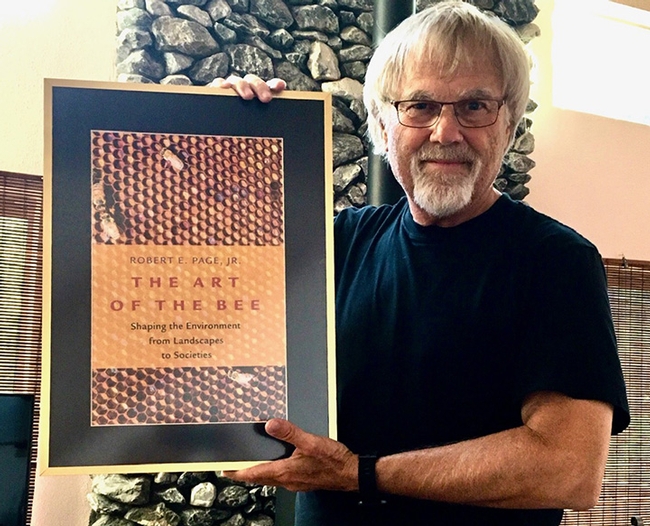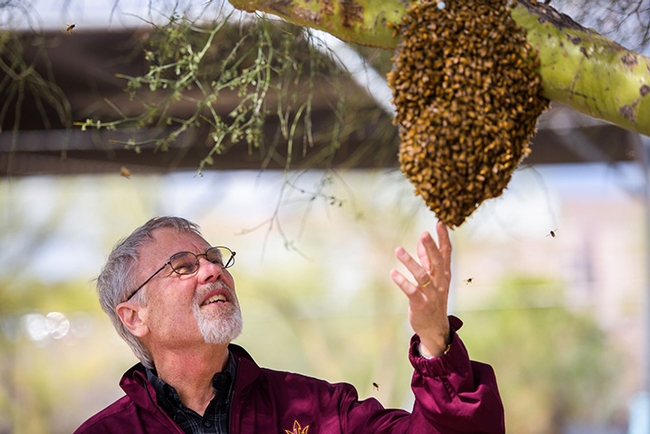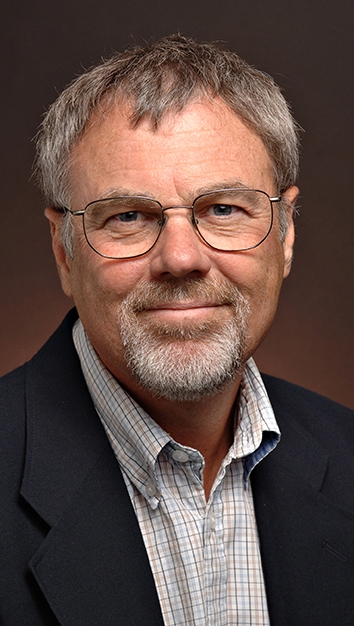
And it's sure to "bee" among the very best.
Eminent honey bee geneticist and biologist Robert E. Page Jr. has authored a 256-page book, “The Art of the Bee: Shaping the Environment from Landscapes to Societies” (Oxford University Press), to be published Aug. 6.
Did you know that honey bees are both artists and engineers?
As environmental artists, they are "responsible for the brilliantly colored flowers in our landscapes," and as environmental engineers, they engineer “the niches of multitudes of plants, animals and microbes.”
The book "is a long time in the making,” said Page, who received his doctorate in entomology at UC Davis and served as a professor and chair of the Department of Entomology (now Entomology and Nematology) before heading to Arizona State University (ASU), where he advanced to school director, college dean and university provost.
“Twenty-five years ago, my friend and mentor Harry Laidlaw (for whom the UC Davis bee facility is named) wanted to write a honey bee biology textbook,” Page recalled. When they finished the outline, “it looked very much like the excellent book by Mark Winston The Biology of the Honey Bee, published in 1987 by Harvard University Press. I decided we didn't need another one, and we still don't.”
The book differs in that it's a collection of “sparkling essays” that “read like mystery stories,” said Rudiger Wehner, professor and director emeritus of the Institute of Zoology, University of Zürich. “With these lucidly written stories, Page takes us on a delightful journey through the many biological traits that on the whole constitute the honeybees' social contract.”
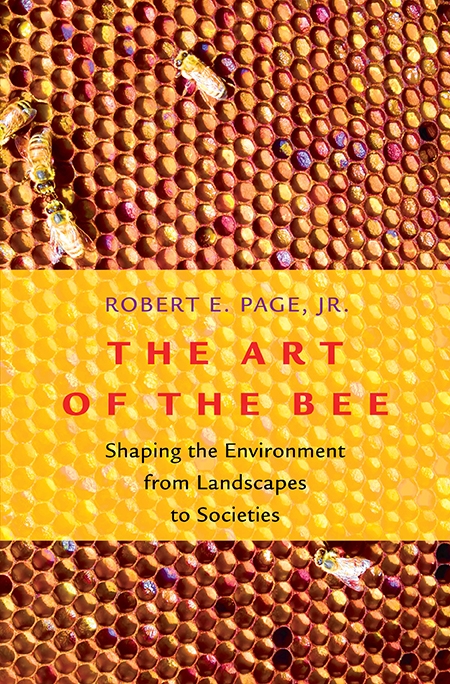
Page said his book is geared toward “the person who has a basic knowledge of biology and a fascination with bees, perhaps an educated hobby beekeeper--there are a lot of them--or an undergraduate or graduate student with an interest.”
“Prior to the rise of flowering plants, the landscape was dull,” Page begins. “The first plants invaded land more than 450 million years ago. Species of ferns, horsetails, club mosses, and other “primitive,” non-seed-producing, non-flowering plants dominated. The earth was painted from a palette of green and brown. The first seed plants were gymnosperms, which originated around 100 million years later and eventually gave rise to the conifers that dominated the earth with massive forests. The first flowering plants, the angiosperms, appeared perhaps as early as 250 million years ago. The rise of flowering plants resulted in a burst of new plant species as they adapted to their insect pollinators, mostly beetles and short-tongued flies. Think of how the landscape changed. “
In addition to chapters on environmental artists and environmental engineering, Page includes chapters on social contracts, superorganisms, reproductive competitions, and concludes with “The song of the queen.”
In the epilogue, Page ponders the complexity of individual bees and their colonies, comparing them to humans. “Members of complex societies live close together in closed nests, shared home sites, villages, etc., or in closely connected nomadic tribes. As groups, they typically have a set of tacit rules by which they live that involves working for the good of the group, systems of group and resource defense, internal mechanisms of policing cheaters that don't cooperate and live by the rules, a division of labor often associated with group defense and gathering and sharing resources, and usually asymmetries and rules associated with reproduction. These same general characteristics seem to apply broadly across eusocial insects (aphids, termites, bees, ants, and wasps), eusocial rodents (naked mole rats), higher apes, and humans. Why? The similarities are inescapable due to the nature of social contracts; they must have specific elements to protect the power and will of individuals, whether citizens of the United States of America or workers in a honey bee colony. The contract binds individuals to a society, but the specific social organization evolves by reverse engineering. Natural selection acts on the whole colony; social structure evolves to fit the needs of the group within a given environment. “
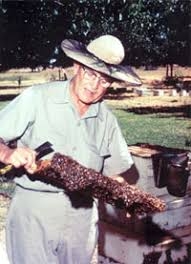
Page points out that “Anthropocentric thinking can obscure the way we view nature and lead to false conclusions. Look at Aristotle and honey bee division of labor: For more than 2,000 years it was thought that the bees that work in the nest were postpubescent old men because they're hairy! In fact, the older bees forage and aren't hairy because the hairs break off as they age. I now see my work in a new light; we aren't so different, bees and humans. The elements of our social structures, and how they come about, have many similarities.”
Page is known for his research on honey bee behavior and population genetics, particularly the evolution of complex social behavior. One of his most salient contributions to science was to construct the first genomic map of the honey bee, which sparked a variety of pioneering contributions not only to insect biology but to genetics at large.
At UC Davis, he maintained a honey bee-breeding program for 24 years, from 1989 to 2015, managed by bee breeder-geneticist Kim Fondrk at the Harry H. Laidlaw Jr. Honey Bee Research Facility. They discovered a link between social behavior and maternal traits in bees.
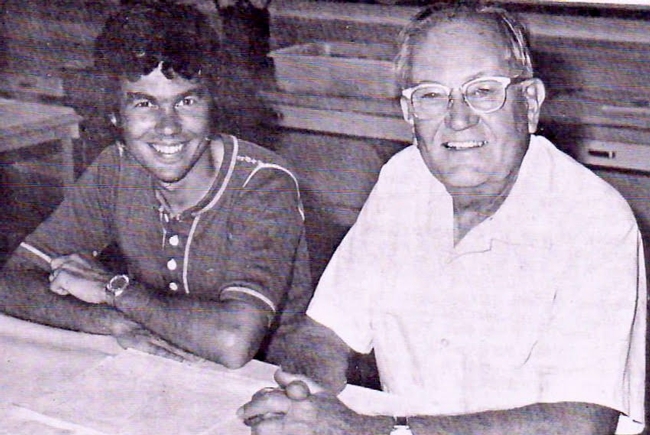
Page has authored more than 250 research papers, including five books. Among them “The Spirit of the Hive: The Mechanisms of Social Evolution” (Harvard University Press, 2013) and “Queen Rearing and Bee Breeding,” with Harry H. Laidlaw (Wicwas Press, 1997). He is a highly cited author on such topics as Africanized bees, genetics and evolution of social organization, sex determination, and division of labor in insect societies.
Page, who received his doctorate in entomology from UC Davis in 1980, joined the UC Davis faculty in 1989 and left as emeritus chair of the Department of Entomology in 2004 when ASU recruited him for what would become a series of top-level administrative roles. He advanced from director of the School of Life Sciences to dean of Life Sciences; vice provost and dean of the College of Liberal Arts and Sciences; and university provost. Today he holds the titles of provost emeritus of ASU and Regents professor emeritus, as well as UC Davis department chair emeritus, professor emeritus, and UC Davis distinguished emeritus professor.
Page is an elected member of the American Academy of Arts and Sciences, the Brazilian Academy of Science, Leopoldina (the German National Academic of Science), and the California Academy of Science. He is a recipient of the Alexander von Humboldt Senior Scientist Award (Humboldt Prize, 1995), the Carl Friedrich von Siemens Fellowship (2013), James W. Creasman Award of Excellence at ASU (2018).
Attached Images:
